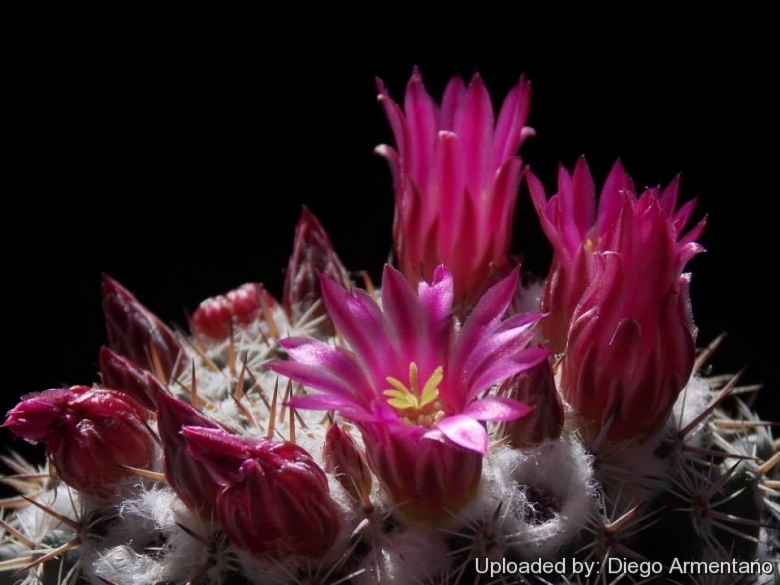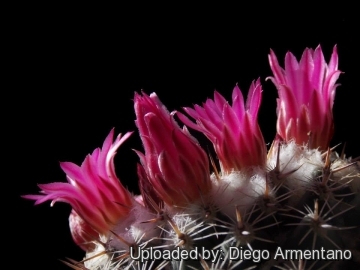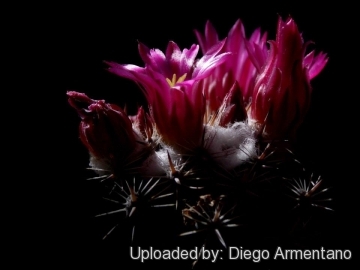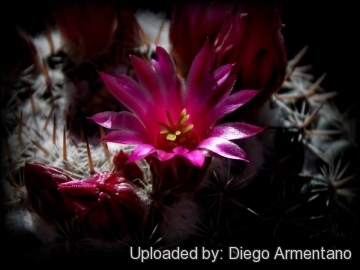Accepted Scientific Name: Mammillaria standleyi (Britton & Rose) Orcutt
Cactography 8. 1926 [ cf: Gentry - Publ. Carnegie Inst. Wash. No. 527 (Rio Mayo Pl.) 196 (1942). ] Orcutt

Mammillaria miegiana Photo by: Diego Armentano
Origin and Habitat: Northem Sonora between Moctezuma and Nacozari, Mexico. Mammillaria miegianaSN|32872]]SN|32872]] occupies the northernmost part of the Mammillaria standleyiSN|9417]]SN|9417]] distribution area.
Altitude range: Altitude 500 - 1.300 metres above sea level.
Habitat and ecology: Mammillaria miegianaSN|32872]]SN|32872]] grows on hills in a mountanious area together with Echinocereus polyacanthusSN|8503]]SN|7070]], Echinocereus pectinatusSN|7070]]SN|8503]], Coryphantha recurvataSN|10231]]SN|10231]], Stenocereus thuberi and Agave parryiSN|247]]SN|247]].
Synonyms:
See all synonyms of Mammillaria standleyi
back
Accepted name in llifle Database:Mammillaria standleyi (Britton & Rose) OrcuttCactography 8. 1926 [ cf: Gentry - Publ. Carnegie Inst. Wash. No. 527 (Rio Mayo Pl.) 196 (1942). ]Synonymy: 24
back
Common Names include:
ENGLISH: Sonora river cactus
SPANISH (Español): Biznaga del río sonora
Description: Mammillaria miegianaSN|9417]]SN|32872]], is a large, solitary species with subglobose stems, appearing white and producing large, dark reddish-pink flowers with scarlet midveins. It is often included within (as a synonym of) the very variable Mammillaria standleyiSN|32872]]SN|9417]], suggesting that there is not really a fundamental difference between the two. It is one of the most densely covered by spines.
Derivation of specific name: This member of the Cactaceae family was given this name in honour of the US cacti collector Charles E. Mieg from Scottsdale. Mieg's mammillaria.
Stems: Globose to short cylindrical, to 16 cm tall and up to 10 cm across. With latex
Tubercles: Four-angled, axils woolly at first, later naked.
Radial spines: 10-11, dirty white, greyish to somewhat dull pink, straight or slightly curved, 8-9 mm long.
Central spines: 2, upper ascending, lower erect, brown, 7-8 mm long.
Flowers: Reddish pink with scarlet midveins, to 20 mm long and 25 mm in diameter.
Fruits: Club shaped, cherry red, to 25 mm long.
Seeds: Reddish brown.
Subspecies, varieties, forms and cultivars of plants belonging to the Mammillaria standleyi group
 Mammillaria floresii Fritz Schwarz: usually solitary. Central spines (2-)4, reddish 5-9 mm long. Radials few to 16, 4-8 mm long. Flowers purplish red to 12 mm long. Distribution: San Bernardo, Sonora.
Mammillaria floresii Fritz Schwarz: usually solitary. Central spines (2-)4, reddish 5-9 mm long. Radials few to 16, 4-8 mm long. Flowers purplish red to 12 mm long. Distribution: San Bernardo, Sonora. Mammillaria lindsayi R.T.Craig: forms clumps up to 1 m wide, has white axillary wool and bristles. Radial spines 10-14 white, centrals 2-4 , straight, brown to black, flowers greenish yellow. Distribution: Chihuahua and Sinaloa, Mexico.
Mammillaria lindsayi R.T.Craig: forms clumps up to 1 m wide, has white axillary wool and bristles. Radial spines 10-14 white, centrals 2-4 , straight, brown to black, flowers greenish yellow. Distribution: Chihuahua and Sinaloa, Mexico. Mammillaria lindsayi var. cobrensis Repp.: is distinguishable from the type for the stem that is always solitary with a very woolly apex. The stem is dark green and it lacks of bristles in the woolly tubercles axil. Distribution: Barranca del Cobre, Chihuahua, Mexico.
Mammillaria lindsayi var. cobrensis Repp.: is distinguishable from the type for the stem that is always solitary with a very woolly apex. The stem is dark green and it lacks of bristles in the woolly tubercles axil. Distribution: Barranca del Cobre, Chihuahua, Mexico.- Mammillaria lindsayi var. rubriflora Hils: as the name implies it has reddish flower.
 Mammillaria miegiana W.H.Earle: mostly solitary with stems, densely covered by spines appearing white and producing large, dark reddish-pink flowers with scarlet midveins. Distribution: Northem Sonora.
Mammillaria miegiana W.H.Earle: mostly solitary with stems, densely covered by spines appearing white and producing large, dark reddish-pink flowers with scarlet midveins. Distribution: Northem Sonora. Mammillaria standleyi (Britton & Rose) Orcutt: very variable, with white radial spine, brownish centrals and white wool between the tubercles. Flowers purplish up to 12 mm long. Distribution: Chihuahua, Sinaloa, and Sonora.
Mammillaria standleyi (Britton & Rose) Orcutt: very variable, with white radial spine, brownish centrals and white wool between the tubercles. Flowers purplish up to 12 mm long. Distribution: Chihuahua, Sinaloa, and Sonora.
Bibliography: Major references and further lectures
1) Edward F. Anderson “The Cactus Family” Timber Press, 2001
2) Orrell T. (custodian) (2016). ITIS Global: The Integrated Taxonomic Information System (version Sep 2015). In: Species 2000 & ITIS Catalogue of Life, 25th March 2016 (Roskov Y., Abucay L., Orrell T., Nicolson D., Kunze T., Flann C., Bailly N., Kirk P., Bourgoin T., DeWalt R.E., Decock W., De Wever A., eds). Digital resource at www.catalogueoflife.org/col. Species 2000: Naturalis, Leiden, the Netherlands. ISSN 2405-8858.
3) Ulises Guzmán, Salvador Arias, Patricia Dávila “Catálogo de cactáceas mexicanas.” Universidad Nacional Autónoma de México, Mexiko-Stadt 2003
4) Urs Eggli, Leonard E. Newton “Etymological Dictionary of Succulent Plant Names.” Springer, Berlin/Heidelberg 2010, ISBN 978-3-642-05597-3, S. 154.
5) Saguaroland Bulletin. Desert Botanical Garden, 26:77 1972.
6) John Pilbeam “Mammillaria The Cactus File Handbook” Nuffield Press. 1999
7) Nelocactus; la uep de les Mammillaries, Echinocereus, Orquidees , Bonsais....i algo de valencianisme – Mammillaria miegiana – Results retrieved 16 April 2016 from <http://www.nelocactus.org/miegiana.html>
8) Cactus and Succulent Field Number Finder – Mammillaria miegiana – Results retrieved 16 April 2016 from <http://ralph.cs.cf.ac.uk/Cacti/finder.php?Plant=Mammillaria+miegiana+>
 Mammillaria miegiana Photo by: Diego Armentano
Mammillaria miegiana Photo by: Diego Armentano Mammillaria miegiana Photo by: Diego Armentano
Mammillaria miegiana Photo by: Diego Armentano Mammillaria miegiana Photo by: Diego Armentano
Mammillaria miegiana Photo by: Diego ArmentanoSend a photo of this plant.The gallery now contains thousands of pictures, however it is possible to do even more. We are, of course, seeking photos of species not yet shown in the gallery but not only that, we are also looking for better pictures than those already present.
Read More... Cultivation and Propagation: This plant is easy to cultivate but slow growing. Cultivate it in a well drained and mineral substratum. Water regularly, avoid the use of peat or other humus sources in the potting mixture. It need full sun, so it keep a compact and flat shape. It does not tolerate intense cold, but tolerates some cold if kept dry. Frequent transplantations of the young plants protect the lower part of the stem from the lignification, to which the plant has a tendency.
Reproduction: It is propagated by seed. Sometimes old plants forms large clumps with several joints - but the removal of one of these joints may prove fatal to the plant.













